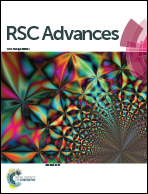Facile synthesis of selenium/potassium tartrate derived porous carbon composite as an advanced Li–Se battery cathode†
Abstract
Porous carbon with a unique 3D structure has been prepared by the immediate carbonization of potassium tartrate. At an optimal carbonization temperature of 700 °C, the carbon mainly composed of micro- and small meso-porous structure has a Brunauer–Emmett–Teller (BET) specific surface area of 816.2 m2 g−1, and the element Se with an amorphous structure is uniformly encapsulated into the porous structure of carbon. The weight ratio of Se in the composite can reach ∼50%. As the Li–Se battery cathode, the composite shows a (2nd) reversible discharge capacity of 550.5 mA h g−1 with an initial coulombic efficiency of 68.2% at 0.24C, and a discharge capacity of 485.3 mA h g−1 can be retained after 80 cycles. Even at a high current density of 1.2C, the cell also delivers a stable discharge capacity of about 452.3 mA h g−1. The good electrochemical performances of the as-prepared composite may be attributed to high specific surface area and small porous size.


 Please wait while we load your content...
Please wait while we load your content...